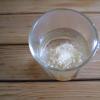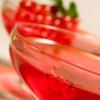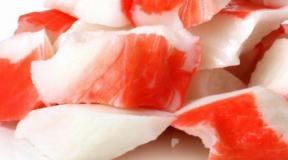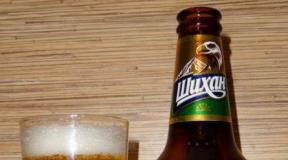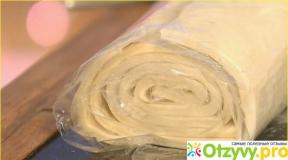The benefits of sea salt for the body. Sea salt benefits
The most common bulk substance in the kitchen, without which no dish is complete, is salt. The seasoning is actively used in cooking, mainly rock salt (sodium chloride). But adherents of a healthy diet choose a healthier product instead of the usual one - salt extracted from sea water. A culinary spice called "sea salt" is no longer news to many housewives. The benefits and harms of sea salt are actively discussed by nutritionists, but nevertheless, sea salt is recognized many times more useful than table salt. How sea salt differs from table salt, how to use it in everyday life and how sea salt is useful - you will find out in our article.
Top 3 Healing Properties of Sea Salt
Salt extracted from the depths of the sea is a real natural storehouse of biological active substances, iodine, macro- and microelements. Depending on the place of extraction of this seasoning, its appearance and taste slightly change. But the nutritional value of sea salt is immeasurably high, it is not for nothing that the use of sea salt is widespread in cosmetology and medicine. Salt from sea water is positioned as a remedy that can cope with many ailments.
So, is sea salt good for most people and what are its medicinal properties? Let's try to figure it out.
- Strengthening health and immunity
The rich natural composition of sea salt makes this food unique. It's no joke, but the composition of unrefined sea salt contains a whole complex of chemical elements. Sea salt in high concentration contains the following substances:
- chlorides- are necessary for a person for a normal digestive process, contribute to the secretion of food juice. In case of illness, they help to restrain the development of dehydration, contribute to the retention of moisture in the body;
- sulfates- their beneficial properties provide healthy intestinal motility, help with flatulence and constipation;
- sodium- is responsible for the strength, endurance of tissues, a sufficient amount of it is necessary to control the heartbeat process and maintain osmotic respiration in a proper state;
- bromine- performs the function of influencing the thyroid gland and its activity in the body, maintains the normal level of hemoglobin in the blood. Also, bromine is necessary for the treatment of insomnia and problems with concentration;
- calcium- an essential element for maintaining the health of bones, teeth, nails and hair. The efficiency of the cardiovascular system is also dependent on calcium;
- magnesium- helps to absorb calcium and produce antibodies, thereby strengthening the defense of the immune system;
- fluorine- is necessary for the prevention of osteoporosis, regulates the metabolic process.
On a note! In its raw form, salt is not eaten, but it is in this state that salt from sea water is a way to work wonders in the treatment of diseases: psoriasis, sinusitis, colds and even acne.
- Losing excess weight
Not so long ago, scientists found out how useful sea salt is for weight loss. It turned out that this spice is able to cleanse the body and intestines in particular from slagging, which contributes to the gradual weight loss.
It is very easy to achieve the desired effect when using salt from the depths of the sea for weight loss. It is necessary to use it not only internally, but also use it as a scrubbing agent and take salt baths.
- Sea salt body scrub has a rejuvenating effect. Scrubbing is carried out at home - you just need to mix 1 tsp. salt with your favorite shower product, and, massaging, apply to problem areas. Sea salt for legs and feet brings excellent results. The skin condition after such procedures improves, the keratinized layer of cells is exfoliated, the body becomes smooth and beautiful.
- Sea salt for cellulite is very effective in salt baths. Add 300-400 g of sea salt to a bath filled with hot water. Run your hand lightly along the bottom to dissolve some of the salt. Take a bath for 15-20 minutes. The salt bath tightens the skin, making it more pleasant, soft and velvety. You can take this healing procedure 3-4 times a month. Sea salt for psoriasis is also useful in the form of taking salt baths.
Note! Sea salt for bath, benefits and harms which are incomparable, it is good with essential oils (ylang-ylang, lavender oil,). A hot bath, combined with aromatherapy, will help relieve stress and pleasantly prepare you for sleep. You can add the essential oil on your own, 3-5 drops of a fragrant product are needed for the bath.
- Prolongation of the youth of the body
Sea salt enriched with iodine, in addition to the above advantages, has an antioxidant effect. When table salt is replaced with sea salt, oxidation processes slow down in the body and cells “age” more slowly. Thus, salt from sea water prolongs youth, takes control of the health of organs and body systems.
What is the difference between sea and table salt?
Using table salt throughout life, it is difficult to imagine that salt from the depths of the sea can replace the product we are used to. Indeed, what is the difference between table salt and sea salt, and how acceptable is the comparison of these spices? Sea salt is much more expensive, and many housewives would like to know in advance what to expect from this product.
1) Method of extraction.
Rock salt, which is in every home, is most often extracted from underground deposits through the development of mines. Such salt is not subjected to processing (heat, water), but foreign additives are often introduced into it in order to improve the color and prevent the crystals from sticking together.
Sea salt is mined in two ways:
- in a natural way, when sea water evaporates under the influence of the sun and salt crystals remain on the surface;
- special evaporation of salt crystals from sea water.
2) Appearance.
Grains of sea salt are several times larger than table salt. There are also color differences. Edible salt has a color close to white, while natural sea salt, due to the presence in the composition of algae, has a grayish-blue tint.
3) Taste qualities.
Salt from sea water has a pleasant taste with rich notes of the sea. Edible salt, in addition to its "salinity", has no extraneous taste. The aroma of sea salt differs from food salt by its specific iodized odor.
4) Nutritional value.
Although both types of salt are the same in terms of the amount of sodium and do not exceed each other, the rest of the chemical composition of food and sea salts is different. Sea salt, the benefits and harms of which cause a lot of controversy, is rich in minerals. It is she who is recommended by nutritionists as a valuable product for a healthy diet.
Important! It is undesirable to heat sea salt. Under the influence of high temperature, beneficial substances are partially destroyed in it. Salt from sea water should be added to food after cooking.
5) Storage.
In terms of shelf life, sea salt exceeds the values compared to ordinary table salt, which has been additionally fortified with iodine. Sea food salt can be stored for more than 12 months without losing its beneficial qualities. Ordinary iodized salt has a shelf life of only six months.
Healing baths with sea salt

Sea salt is a magical foot care product. This spice will help to deal with fungus, corns and unpleasant odors after wearing shoes. The sea salt foot bath helps the feet to relieve tension, relax and soften rough skin.
To prepare a salt bath, you need to pour water into a suitable container, which is comfortable for immersing your feet. The water should be temperature tolerant, but always hot. Add 10 g of sea salt to the water. There is no need to specifically dissolve the crystals. Submerge both feet in the bath for a quarter of an hour. Then treat your toes and heels with a pumice stone, rinse your feet with cool water and wipe dry.
Doctors practice such baths with sea salt after a fracture, because the effect of healing sea salt occurs even on cartilage fibers.
Sea salt for youth and beauty

The use of a spice given to us by nature itself is widely used for cosmetic purposes. Sea salt is the main ingredient in many healing masks, body wraps and body care products.
- Sea salt for hair is beneficial in that it accelerates hair growth by increasing blood circulation in the tissues. Salt can be used as a peel by mixing a handful of spices and mixing it with shampoo. Gently, effortlessly rubbing salt into the hair roots over the entire surface, you can get rid of annoying dandruff and prevent hair loss. After massaging the head, such a "scrub" must be thoroughly washed off with water.
- Hair mask with sea salt and strengthens the roots. It is necessary to knead a ripe banana into gruel, and mix with 5 g of sea salt. Lubricate the hair with the resulting mixture, paying special attention to the hair roots. Put on a hair cap and hold the mask for half an hour, then rinse it off with shampoo and rinse your hair well.
- Salt from sea water has a no less favorable effect on the nail plates. Sea salt for nails is used in the form of mini-baths. The nails should be free of varnish. Add a tablespoon of sea salt and the same amount of lemon juice to a glass of warm water. Pour the product into a container, dip your fingers into it and hold for 15 minutes. Then wipe dry, moisturize your hands with cream. The nails will become less brittle and grow faster.
- If you use scrubs, then sea salt for the body will do the job just fine. Mix 1-2 tsp. salt with, and get a scrub - a paste for the body, which is used in expensive beauty salons. Use it on your thighs, buttocks, stomach, and you will notice how your skin will change for the better.
- It's no secret that sea salt for acne is also used in cosmetology. It is good for owners of oily skin to treat their face with a solution of soap and salt. Dissolve 5 ml of liquid soap in a glass of water, add 1 tsp. sea salt, mix and apply the solution with a swab on the face. Wash off after light pinching of the skin (3-5 minutes).
Benefits of rinsing your nose with sea water
Rinsing the nose with salt water is a procedure that can prevent the development of a cold and speed up the healing process. Pediatricians have recommended sea salt for rinsing the nose for children as a safe therapeutic procedure for treating rhinitis. So, what is sea salt useful for rinsing the nose:
- relieves swelling from the mucous membrane of the nasal passages, thereby facilitating the breathing process;
- removes mucus containing bacteria that caused colds;
- removes dust particles and other allergens from the nasopharynx;
- stimulates cellular activity in the nasal cavity, increases local immunity.
Thus, the salt water eliminates the runny nose, and after the first procedure, relieves nasal congestion. Sea salt is used for sinusitis, rhinitis and as a prophylactic agent during periods of seasonal exacerbations of ARVI.
Preparing the brine for rinsing
If you do not know how to dilute sea salt for rinsing the nose, then he offers you a simple recipe for making a solution for rinsing the sinuses at home.
Necessary:
- 200 ml of boiled water,
- 2 tsp sea salt,
- pipette.
Preparation of the solution: cool hot boiled water to a warm state. Add salt to a glass of water, and stir thoroughly until the salt crystals are completely dissolved. Then strain the solution through a fine sieve or cheesecloth. Instill the resulting solution with a pipette or syringe, 5 drops in each nostril, then wait 0.5 minutes and blow out the contents of the nose. For convenience, you can pour the solution into a special dispenser for rinsing before use. It can be purchased at the pharmacy.
Adults can add 1 drop of iodine to the solution for greater effectiveness of the product. Many people are interested in whether it is possible to gargle with sea salt - yes, it is such a solution that is suitable for gargling with diseases of the oropharynx.
Important! If you plan to use sea salt for children, it is better to purchase a special nasal rinse at the pharmacy to avoid dosage errors at home. Sea salt for babies in the form of drops can be used safely after one month of age.
It is difficult to find a person who has not experienced the healing properties of sea water in his entire life. Its benefits for the body are primarily associated with the large amount of salt it contains. Sea salt has been mined by humans since ancient times and continues to be widely used in cooking, cosmetology, medicine and other industries.
Sea salt concept. Where is it mined?
The name "sea salt" speaks for itself. It is a natural flavor enhancer that is not extracted from the bowels of the earth, but is formed by natural evaporation from the depths of the sea. It preserves the natural balance of useful minerals and trace elements necessary for human life. They began to get it back in ancient times. The famous ancient Greek physician Hippocrates, already in the 4th century BC, described the healing properties of sea salt.
The leader in the production of this seasoning is the United States. The largest salt pools are located here. However, sea salt produced in America undergoes additional processing. That is why, in terms of taste and nutritional properties, it is very similar to ordinary table salt.
To date, sea salt is considered the best, produced in France. In the small town of Guérande, a useful spice is extracted by hand, therefore it preserves all the unique minerals and trace elements of the Mediterranean Sea.
Dietary sea salt, with a minimum content of sodium chloride, while rich in potassium and magnesium, is extracted from the Dead Sea. This spice is especially suitable for people who are advised to limit their salt intake.
It should be noted that in recent years, the demand for sea salt has grown tremendously, and this has contributed to an increase in its production.
What is the difference between sea salt and regular table salt?
Despite the fact that sea salt and table salt practically do not differ from each other in taste, and sodium chloride is the main constituent substance in both cases, there are several fundamental differences between them.

First, edible sea salt is obtained by natural evaporation from water. This natural process takes place without additional human intervention. As a result, salt crystals naturally formed in the sun do not have a shelf life.
Secondly, sea salt practically does not undergo chemical processing. It is not bleached or artificially evaporated from water bodies. This explains why its color is not snow-white, like ordinary table salt, but grayish or reddish, with an admixture of ash or clay, respectively.
Thirdly, the salt obtained from sea water contains a large amount of minerals and trace elements. In total, it contains about 80 useful components. There is especially a lot of iodine in this composition, which is so necessary for pregnant women and children to develop their mental abilities. Food iodized sea salt does not lose its useful properties, regardless of the time and place of its storage. This is how it differs from table salt, where iodine is added artificially and therefore very quickly disappears.
Edible sea salt: mineral composition
Any salt in its composition is sodium chloride. Further, during subsequent processing, microelements are artificially added to ordinary salt. Marine, on the other hand, initially contains them in large quantities and in a balanced ratio. The main elements in the composition of such salt are:
- potassium - is responsible for the stable functioning of the human heart;
- calcium - needed for strong bones, good blood clotting and quick wound healing;
- iodine is an essential component for the normal functioning of the thyroid gland;
- magnesium - is needed for the stable functioning of the nervous system, has a vasoconstrictor and relaxing effect;
- zinc is an important component of male sex hormones and an effective agent in the fight against cancer cells in the body;
- manganese - participates in blood formation;
- selenium is an active component in many cellular compounds, its lack prevents the assimilation of iodine by the body.

The composition of edible sea salt contains many elements that have a beneficial effect on the functioning of the human body. In small quantities, it may contain particles of clay, volcanic ash and algae. The content of certain elements in the composition may differ significantly depending on the place of its extraction.
Useful properties of sea salt
Everyone knows about the benefits of sea water for the human body. It carries health, has a beneficial effect on the skin and the internal state of the body. The usefulness of edible sea salt is determined by its unique mineral composition. Each constituent element ensures the well-coordinated work of the whole organism.

Eating sea salt every day instead of the usual stone salt has a beneficial effect on strengthening the immune system and increasing vitality. It is an effective remedy in the treatment of diseases of the gastrointestinal tract, endocrine and cardiovascular systems. Metabolic processes, blood formation, the musculoskeletal system and the nervous system begin to work stably and harmoniously. Like seawater, salt dissolved in a home bath makes the skin supple and firm.
Many people daily take certain vitamins that respond to the work of a particular organ or system. The use of sea salt allows you to limit the use of table salt, which is harmful to the body.
Is sea salt harmful?
At times it may seem that the sea salt used as food has no harmful qualities at all and only benefits the body. But it is not so. Sea food salt, the benefits and harms of which have recently begun to be closely studied by scientists from all over the world, just like ordinary table salt, contains a large amount of sodium chloride. Therefore, you should limit your salt intake to one teaspoon per day. This will help to avoid high blood pressure and reduce the risk of heart failure and stroke.
Types of sea salt
All sea salt that is intended for human consumption varies according to the degree of grinding. Depending on this, there is coarse, medium and fine salt. The first type is used in the preparation of liquid dishes, cereals and pasta. It dissolves perfectly in water, while retaining all the beneficial properties.

Edible sea salt of medium grinding ideally emphasizes the taste of meat and fish dishes. It is also good for baking and pickling.
Fine salt is best suited for salad dressing. It can be poured into a salt shaker to be used directly in the process of eating.
Edible sea salt for weight loss: myth or reality
Sea salt has been shown to help you lose weight. To achieve the maximum result in losing weight, along with eating it, you should also use cosmetic procedures and healing baths.
If you just use sea salt instead of table salt every day, the weight will already begin to decrease. This is because sea salt, unlike ordinary stone salt, does not retain fluid in the body. It removes toxins and toxins, relieves constipation, accelerates metabolic processes. Together with sports activities, the benefits of sea salt for weight loss will become obvious.
How to lose weight with sea salt: traditional medicine recipes
Losing excess weight should begin with cleansing the body. By improving digestion, you can get rid of constipation, slagging and toxins.
This will help a useful drink for cleansing the intestines from sea salt. To prepare it, you will need one liter of warm boiled water, two tablespoons of sea salt and a few drops of lemon juice. The healing drink should be taken in the morning on an empty stomach for two weeks. Sea food salt, the benefits and harms of which are the cause of many controversies, brings health to the body.
The effect on the figure will be greater if, together with ingestion, organize a sea bath several times a week. After such a procedure, the skin will be cleansed of dead cells, it will become elastic and taut. To prepare a slimming bath, prepare 500 grams of sea salt and a few drops of essential oil to help you relax. Cypress and juniper normalize metabolic processes, remove toxins and relieve swelling, and orange oil will help get rid of toxins.
An effective remedy for problem skin
On the basis of sea salt, you can prepare an affordable and effective remedy for the treatment of acne. For daily washing, dilute 2 tablespoons of salt in a glass of still or boiled mineral water. By applying this remedy for two weeks in the morning and in the evening, you can quickly get rid of acne.

Healing herbal infusions enhance the properties that food sea salt has. Its use in the treatment of problem skin consists in a drying and healing effect that can be achieved. Add 2 tablespoons of sea salt to a glass of herbal infusion of calendula flowers. Pour the resulting product into ice molds, place in the freezer. After freezing, rub face with ice cubes daily until final recovery.
Sea salt for hair
Edible sea salt will help to make hair strong, healthy and thick, both in dry form and as an additional component to a kefir mask. In the first case, it is rubbed into the scalp and acts as a scrub. With this use, dead cells are exfoliated, thereby providing oxygen access to the hair roots and their intensive growth. Sea salt removes excess sebum and normalizes the sebaceous glands. Therefore, its use is especially recommended for oily roots.
The minerals in sea salt restore damaged hair and nourish it along its entire length. You can achieve a greater effect if you add it to the composition of other masks, for example, based on kefir. Sea salt will enhance the effect of the active components of this fermented milk product, and the mask will become even more complete and nutritious.
How to choose quality sea salt
There are several key points to consider when choosing sea salt.
First, the color of the spice is important. Traditionally, sea salt has a grayish tint. This is due to the lack of any processing and bleaching during extraction and production. The exception is the snow-white French salt "Fleur-de-Sel".
Secondly, you need to pay attention to the composition. In sea salt, there are 4.21 grams of potassium per 100 grams of product. If the content of this element is less, then ordinary kitchen seasoning is sold under the guise of sea salt.
Thirdly, sea salt should be free of colorants, aromas and flavor enhancers. She herself has a unique taste that does not need to be clogged with various food additives.
Dear friends! The use of sea salt in traditional medicine is what we are going to talk about today.
Sea salt is rich in various trace elements that are necessary for the full functioning of our body. By adding it to food, we saturate our body with useful microelements from the inside. When used wisely in food, we prevent the development of certain diseases. But you can not only prevent, but also treat with it. It should be noted, however, that sea salt alone cannot cure your health problems. It will be an excellent addition to the main traditional treatment or to traditional methods of treatment.
Have you ever thought about why after a seaside vacation a person always looks much younger and more beautiful? And here sea salt helps to preserve the beauty of your skin. Bathing in seawater will invigorate and tone your body, strengthen your immune system, and your skin will be nourished with useful microelements.

In case of poisoning, sea salt will help you again. To do this, it must be drunk with vodka. If this is not acceptable for you, then just drink up to 1 liter of sea salt solution.
My dear readers! If this article was useful to you, then share it with your friends by clicking on the social buttons. networks. It is also important for me to know your opinion about what you have read, write about it in the comments. I will be very grateful to you.
Good health wishes Taisiya Filippova
Everyone has probably seen sea salt on the shelves of pharmacies and shops more than once. It is obtained mainly naturally from various seas. It is quite different from ordinary table salt, because there are a lot of various useful minerals in sea salt. Sea salt was mined in ancient times. It has been used in cooking and medicine for centuries. What useful properties it carries in itself and how to use it, you will learn from this article.
The benefits of sea salt
As already mentioned, sea salt is different from table salt. Salt extracted from the sea contains more than 80 trace elements necessary for the health of the body. For example, it contains potassium and sodium, which play a large role in regulating nutrition and cleansing cells. Calcium heals wounds, prevents various infections. Magnesium prevents the skin from aging and relaxes the muscles.
Manganese strengthens the immune system, forms bone tissue. Bromine soothes the nervous system. Selenium prevents the development of cancer. Iodine is involved in the regulation of hormonal levels. Silicon strengthens tissues and blood vessels. Due to the fact that salt is mined from different seas, its composition may differ. For example, salt extracted from the Dead Sea is most used in the field of cosmetology.
By consuming sea salt inside the body, you can get rid of many diseases. It can lower blood pressure, cholesterol levels. Salt is used to treat skin diseases, improve immunity, and reduce excess weight. Also, salt is effective in asthma. Salt baths are used to relieve stress, depression, and normalize sleep.
Harm of sea salt
Many people think that sea salt is completely harmless. In fact this is not true. Yes, there are many pluses and positive properties in it. But, like many other remedies, it should be taken in moderation. If consumed in excess, sea salt can cause enormous harm to the human body. Blood pressure may rise, followed by a stroke or heart failure. In addition, vision may deteriorate, problems with the nervous system will arise. Also, do not forget about allergic reactions, which will also not lead to anything good.
Sea salt: contraindications

The use of sea salt is strictly contraindicated for people suffering from:
- hypertension;
- tuberculosis;
- stomach ulcer;
- skin diseases;
- swelling;
- kidney failure;
- sexually transmitted diseases;
- glaucoma;
- infectious diseases.
Pregnant and lactating women should use sea salt with extreme caution. Also, salt with additives and fragrances should not be used for people with skin problems and allergies.
Application of sea salt

This useful product is used in many areas: cooking, medicine, cosmetology. Since salt practically does not undergo any processing, all useful minerals and trace elements remain in it. So you can safely replace ordinary table salt with sea salt in the kitchen. True, you need to put it a little less. If the salt is finely ground, then the food should be salted after cooking. And large crystals can be placed during cooking, as well as during conservation. It can be safely used in combination with various (spices, onions, basil, seaweed).
In the field of cosmetology, sea salt is also quite famous and relevant to this day. Various masks, creams, scrubs, lotions are made from it. It is used for wraps, baths. Used to treat hair, marigolds, body skin and face. Due to the large amount of useful substances, the skin becomes much more elastic, more toned and noticeably younger.
Sea salt is actively used in balneotherapy (healing with the help of mineral waters). And also for the treatment of various other diseases. With its help (with long and constant use) you can cure rheumatism, hypertension, various types, sciatica, conjunctivitis, sinusitis, otitis media, arthritis, mastopathy, constipation and diarrhea.
Sea salt for hair

If you suffer from loss, or they are thin, break, dry, then in any of these cases sea salt will help out. The damp product can simply be rubbed into the hairline roots. By cleansing the scalp from keratinized dead particles, metabolic processes will improve, excess fat will be removed.
Also, salt can be combined with sour cream, essential oils, yogurt, mayonnaise and other products. Be sure, after applying to the hair, cover your head with a film and a towel for about an hour.
A scalp scrub can be made with 100 g of sea salt, 10 drops of castor oil, and 5 drops of cinnamon oil. Mix all ingredients together. Before washing your hair, apply the peeling to the scalp, massaging thoroughly for 25 minutes.
You can also make a hair spray that will strengthen its structure, make it smooth and healthy. It will require 100 ml of mineral water, 5 drops of oil and 20 g of finely ground sea salt. Dissolve the salt in mineral water and drip oil. This spray can be poured into a spray bottle to make it easier to spray. Spray to the entire length of the hair every couple of days.
Sea salt for face

Sea salt cleanses and tightens clogged pores, dries and regenerates them. For face care, masks, creams, tonics, etc. can be made from this product. All the ingredients for such products are readily available and cost very little.
You can prepare a lotion to cleanse and remove dirt. You will need 30 g of sea salt, 10 g of baby soap, 50 ml of mineral water, 20 ml of heavy cream. Mineral water needs to be heated a little, pour cream into it and add salt. Grate the soap and add to the mineral water. Mix everything thoroughly. You can use this lotion a couple of times a day.
For you need 5 g of soda, 10 g of salt, 20 gel. Mix all the ingredients. Apply to face with massage movements. To make a refreshing face toner, you need 30 ml of mineral water, a couple of cucumbers and 8 g of salt. Heat the mineral water and dissolve the salt in it. Grate cucumbers and squeeze juice from them. Add it to mineral water.  For you can use 30 g of fat sour cream, 10 g of salt, a couple of drops of bergamot oil, 5 g of shea butter. Combine all ingredients and beat until creamy states. Apply to steamed face skin, covering with foil for 20 minutes.
For you can use 30 g of fat sour cream, 10 g of salt, a couple of drops of bergamot oil, 5 g of shea butter. Combine all ingredients and beat until creamy states. Apply to steamed face skin, covering with foil for 20 minutes.
Rejuvenating nourishing cream - 5 g of salt, a couple of drops of jojoba oil, a drop of wheat oil, a capsule and 10 g of baby cream. Mix all products with each other. Apply once a day, before bedtime. If it seems to you that the cream is too oily, then it can be diluted with mineral water.
Sea salt for body

Sea salt peeling can be done not only for the face, but for everything. For example, you can combine sea salt and grounds by adding olive, almond or sesame oil and a couple of drops of any essential oil.
To get rid of the orange peel, you need salt and honey. They need to be mixed and massaged onto the skin. To enhance the effect, you can add a few drops of orange, lemon or grapefruit.  You can also take baths with the addition of sea salt. This bath helps to smooth and rejuvenate the skin. In a warm bath, add 400 g of sea salt and 200 g of dried seaweed.
You can also take baths with the addition of sea salt. This bath helps to smooth and rejuvenate the skin. In a warm bath, add 400 g of sea salt and 200 g of dried seaweed.
Or you can take a pound of sea salt, a couple of liters of fat milk, 10 drops and 20 drops of almond oil. Add all ingredients to a warm bath. Salt will cleanse, milk will rejuvenate the skin, make it elastic, and oils will nourish the skin.
To get rid of on the body, you need to add a kilogram of sea salt (about 38 degrees). Take such baths every couple of days for 10-15 minutes. Also, such baths can save you extra pounds. For the best effect, you can also add soda (relieves stretch marks). Essential salts can be added to salt baths to make the skin more hydrated and nourished.
Sea salt can be combined with algae gruel. With this mass you can do. You just need to spread it on problem areas, covering it with a film. Hold for 40 minutes, rinse and grease with cream.
Sea salt for nails

For marigolds, sea salt is also very beneficial. It is best to do baths with it. The nails will steam and the sea salt will strengthen and restore the nail plate. In order not to will need to exfoliate 50 g salt, 30 ml lemon juice, 6 drops of rosemary oil. Heat the water to 40 degrees and add all the products to it.
In order to grow faster, you can pour 4 drops of olive, 15 drops of iodine into a hot bath and add 30 g of salt. Steam the handles for half an hour.
Can also be used for soaking, lemon oil and sea salt. Heat water and 50 ml of vinegar to an acceptable temperature. Dissolve the salt in water and add essential oil.
Sea salt for children

Recently, salt has become popular in the field of pediatrics. Experts say that such procedures have a positive effect on the child's body. Salt eliminates neurological disorders, rickets and birth injuries. In addition, it greatly improves children's sleep, blood clotting, decreases colic, and soothes. It also has a beneficial effect on the respiratory organs, acid-base balance and increases hemoglobin.
Salt also affects the musculoskeletal system, blood vessels and cardiac activity. Increases blood circulation, metabolism. Analgesic, anti-inflammatory property for children suffering from diathesis, dermatitis. Strict rules must be followed to ensure that such procedures are only beneficial. The temperature regime of the water should be no more than 36 degrees. For babies, the bathing time is no more than 10 minutes, for older children, about 20 minutes. Before starting the session, you should carefully study how and in what quantities to add sea salt. Do not under any circumstances swallow salt water or get it in the eyes.
If you decide to bathe in salt baths, first consult a specialist. Since for some diseases, taking baths with sea salt is strictly prohibited. If you notice reddening of the skin while bathing, then it is better to avoid such procedures in order to avoid allergic reactions.
Sea salt treatment

To ease the work of the heart, you can take baths with sea salt every other day. To do this, dissolve a couple of kilograms of sea salt in water. Stay in such baths for 15 minutes. The course is 10-15 times. You need to lie calmly, relaxed and your legs should be raised.
In chronic diseases of the kidneys, liver, arthritis, neuropsychiatric diseases, hot baths (40-42 degrees) have a very positive effect. Such procedures should be done with extreme caution for people with cardiovascular diseases.
Salt baths will help get rid of eczema, psoriasis, osteochandrosis, as well as improve joint mobility, relieve rheumatism spasms.
A warm bath with the addition of sea salt and a few drops of oil (lavender, mint, chamomile) can relieve nervous tension, stress and depression.
For colds, acute respiratory viral infections, diseases of the bronchi and nasopharynx, inhalation will help. A couple of times a day, you need to dissolve two tablespoons of salt in a liter of water, boil for 5 minutes and inhale the vapors from the salt water. If problems with the bronchi need to be inhaled through the mouth, exhaled through the nose, the nasopharyngeal disease is treated in the opposite way.
If you have sinusitis, tonsillitis, or colds, you can dissolve a spoonful of sea salt in a glass of water. With a syringe, draw up the liquid and pour it into any nostril. The head should be tilted, water should pour out of the other nostril. You can also gargle with the same mixture.
With varicose veins, you can make salt compresses. Pour salt with water (proportion 1: 1), stir until dissolved. Cool to zero degrees, put on cheesecloth. Put the gauze on problem areas, strengthening with an elastic bandage. Wait for heating, after which it is necessary to grind this area of the skin.
Back in the days of Hippocrates, people noticed that salt from the sea has medicinal properties, in particular, it has a beneficial effect on the regenerative processes in the body. But the beneficial properties of sea salt are not limited to this.
History of sea salt
Sea salt is extracted from sea water. Residents of countries with hot climates (Italy, Greece) were the first to mine sea salt. For this, a network of shallow ponds was created. The first pond received sea water through canals. Under the scorching sun, it began to evaporate. The heavier minerals were the first to settle. After the start of this process, the water was distilled into a second (shallower pond), where the procedure was repeated. Then the rest of the water was distilled into the third pond, and so on. In the last pond there was practically pure water without impurities. After the water in this pond dried up, only salt remained at the bottom. This method is still used today. About 6-6.5 million tons of sea salt are produced in the world annually.
Interestingly, sea salt is mined not only in countries with hot climates. In colder countries, salt is simply evaporated from sea water in special vats. So sea salt was obtained in England and Russia.
The composition and benefits of sea salt
In terms of its chemical composition, sea salt is very rich in macro- and microelements. It contains potassium, calcium, iodine, magnesium, bromine, chlorine, iron, zinc, silicon, copper, fluorine. Thanks to this composition, sea salt:
- has a beneficial effect on the cardiovascular system,
- reduces the level of development of diseases of the musculoskeletal system,
- reduces the risk of developing thyroid diseases,
- participates in cell regeneration,
- helps to increase the elasticity of the skin,
- has an antiseptic effect,
- helps to relieve pain,
- helps to reduce stress,
- increases overall vitality.
Sodium and potassium contained in sea salt accelerate metabolic processes in our body, iodine acts as a regulator of lipid and hormonal processes, calcium prevents the development of infections, manganese helps to strengthen immunity, zinc has a beneficial effect on the reproductive system, iron helps the formation of new red blood cells in the blood, and magnesium has anti-allergic properties .
Sea salt can be consumed internally and used externally.
Internal use of sea salt
When buying sea salt to add to food, you need to pay attention to the potassium content in it. Sea salt has a nondescript grayish color, which tastes little different from ordinary table salt.
It is believed that eating sea salt is much better than eating table salt. However, this is a controversial statement. Both types contain chlorine ions, which is the main material for the production of  of hydrochloric acid. Hydrochloric acid is an essential component of gastric juice. In addition, both salts contain sodium ions, which, together with the ions of other elements, are involved in the transmission of nerve impulses and the contraction of muscle fibers. Therefore, the body is not important for the salt itself, but the chlorine and sodium ions that it contains. Without these ions, the human body is unable to function normally.
of hydrochloric acid. Hydrochloric acid is an essential component of gastric juice. In addition, both salts contain sodium ions, which, together with the ions of other elements, are involved in the transmission of nerve impulses and the contraction of muscle fibers. Therefore, the body is not important for the salt itself, but the chlorine and sodium ions that it contains. Without these ions, the human body is unable to function normally.
Since salt is the most affordable option for obtaining the necessary ions in the right amount, a person eats it. It is enough to consume 10-15 grams (in places with hot climates 25-30 grams) of salt per day. But sea salt, in comparison with table salt, has a large set of macro- and microelements. This is the difference between them.
It is worth remembering that it is better to salt ready-made food than the one in the cooking stage. So salt is consumed less, and its content in food increases.
External use of sea salt
A hot bath with the addition of sea salt cleanses the pores, and the silicon contained in it makes the skin supple and elastic. In addition, bromine, along with hot air vapor, enters the body through the respiratory tract, which relieves stress and calms the nervous system. Calcium, penetrating through the cleansed pores, promotes rapid healing of wounds and bruises, and also strengthens the cell membranes.
A bath with a water temperature of 36 ° C and with the addition of sea salt helps to strengthen the immune system (the bath should be taken within a month, every other day).
Inhalation of sea salt solution is used in the treatment of diseases of the upper respiratory tract.
Since salt increases the sensitivity of the skin, its use is contraindicated in some skin diseases (neurodermatitis, psoriasis, rosacea).
Due to its high hygroscopicity, sea salt should be stored in a dry sealed container.
So, sea salt can really be considered a natural treasure of valuable substances, a gift from the sea. Its applications are multifaceted and the properties are amazing. But remember that sea salt is also salt, so its use should be limited to the needs of the body.



